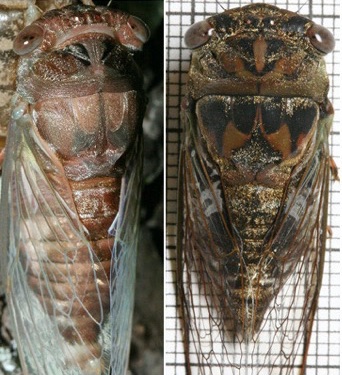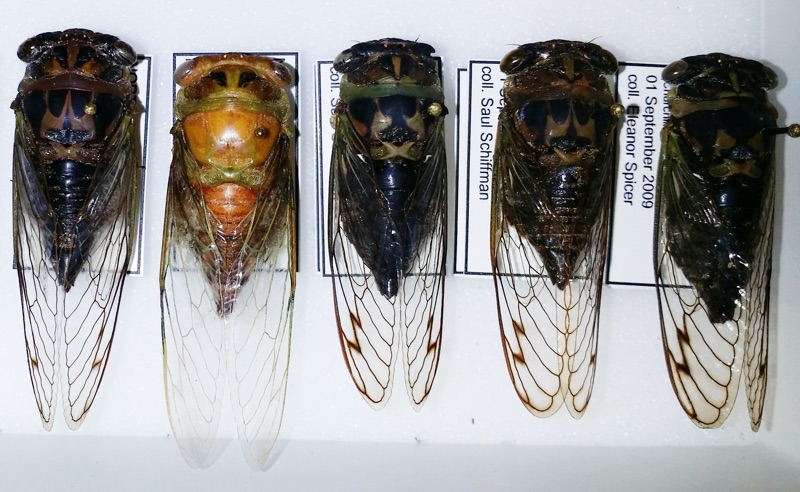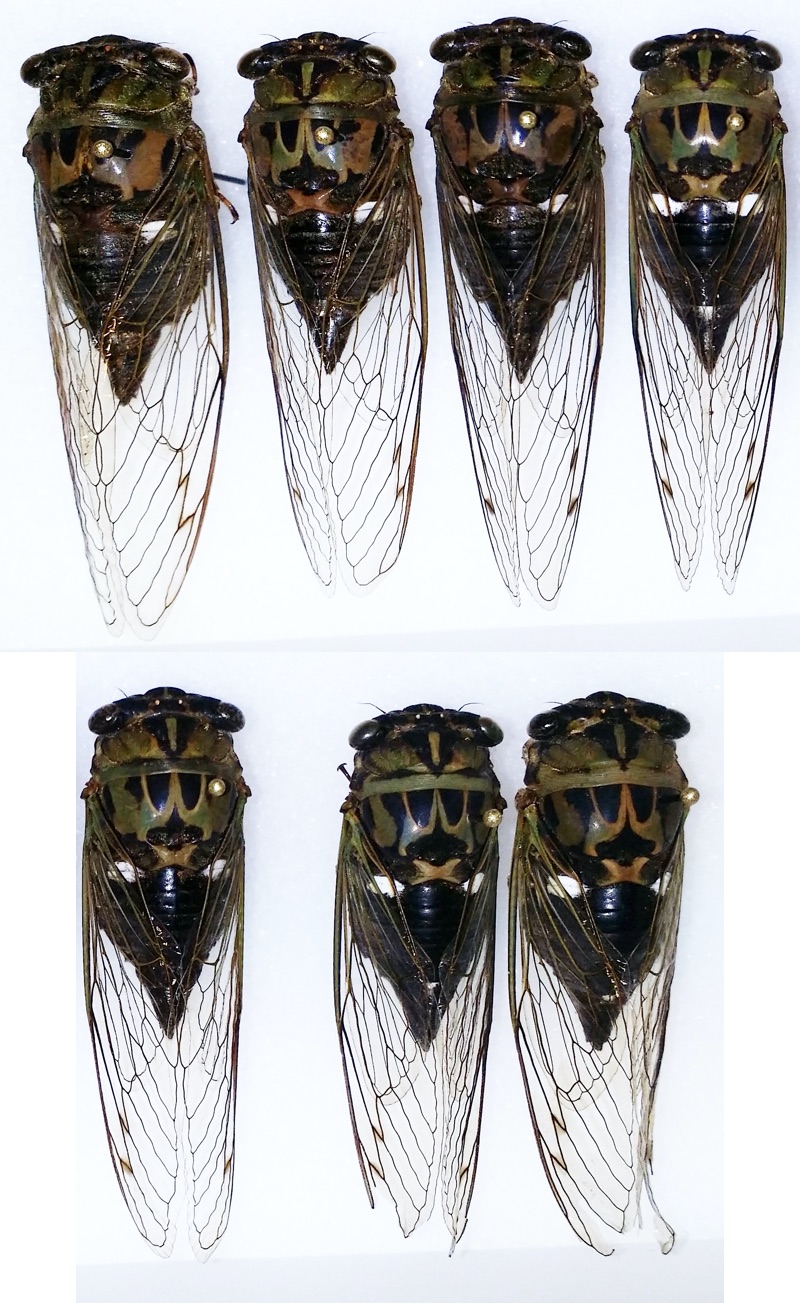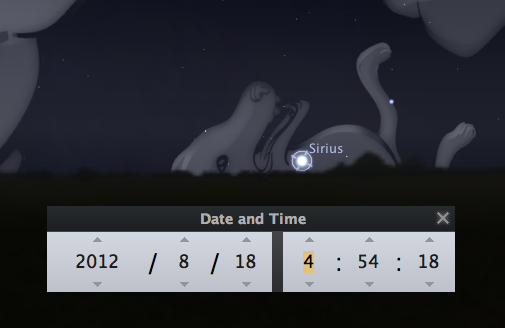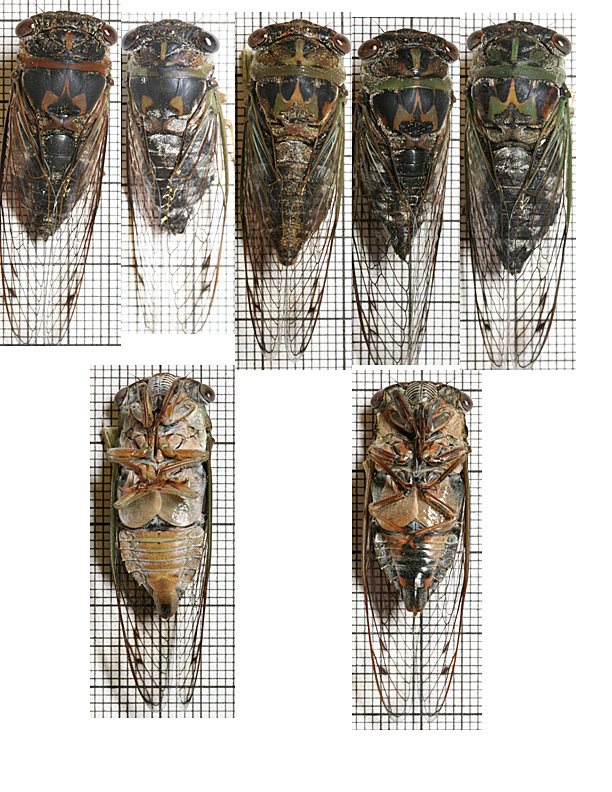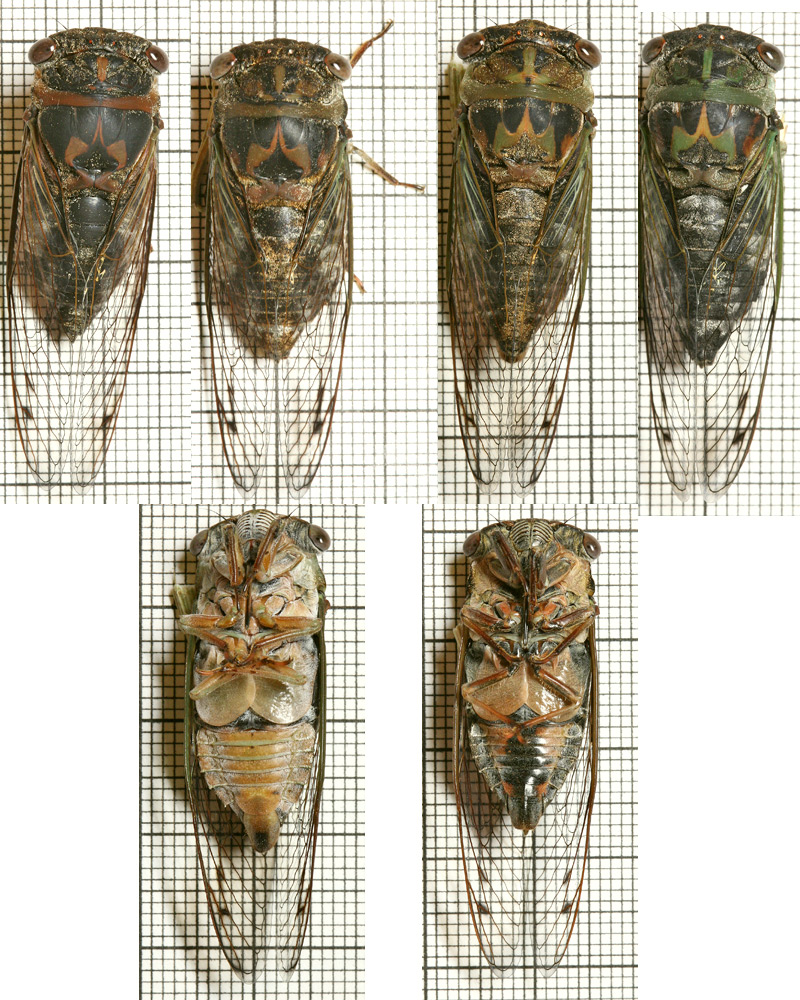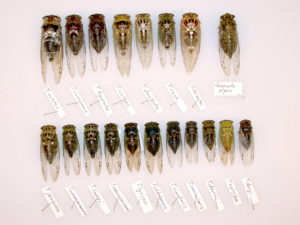Neotibicen davisi aka Davis’ Southeastern Dog-Day Cicada.
There are two sub-species of Neotibicen davisi, and it makes sense to discuss both on the name page.
- Neotibicen davisi davisi (Smith and Grossbeck, 1907). Quick ID: it has black on its abdomen.
- Neotibicen davisi hardeni Davis, 1918. Quick ID: it lacks the black on the abdomen, and is only found in Arkansas and Mississippi.
In this photo, N. davisi hardeni is on the left, and N. davisi davisi is on the right:
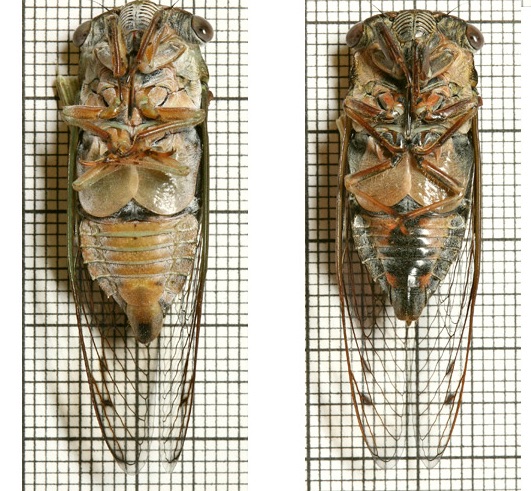
Photo by Paul Krombholz.
See all davisi davisi and davisi hardeni images & info on cicadamania.com.
Songs:
“Probably Tibicen davisi harnedi”. Source: ©Insect Singers.
Neotibicen davisi davisi. Source: ©Insect Singers.
Identification keys by Wm. T. Davis from MISSISSIPPI CICADAS, WITH A KEY TO THE SPECIES OF THE SOUTHEASTERN UNITED STATES. 1
A. Large, heavy bodied species ; head broad, uncus simple, and first cross vein in the fore wings starting from radius 3 far back, or about one third distant from base of first marginal cell.
B. Uncus longer than broad. Black species with green or greenish markings and black area on the central part of the abdomen beneath, except in sayi, and new variety of davisi.
C. Hind margin of pronotum or collar, green or greenish.
Neotibicen davisi hardeni Davis, 1918:
Abdomen greenish centrally on under side, blackened area
wanting, marginal cells of fore wings clouded.
davisi var. harnedi new variety.
Neotibicen davisi davisi (Smith and Grossbeck, 1907):
An irregular band of black on the under side of the abdomen, head rounded in front ; a rather small species.
davisi (Smith & Grossbeck).
Description of Neotibicen davisi hardeni Davis, 1918 1:
Tibicen davisi var. harnedi new variety, PI. VII, fig. 4.
Type male, Helena, Arkansas, June, 19 16 (K. D. Jacob). Davis
collection.Allotype female, Rodney, Jefferson Co., Miss.. August, 1917 (O.
A. Hammett). Collection, Miss. Agri. and Mechanical College.More robust than typical davisi, with broader wings, the first seven marginal cells of the fore wings being clouded much as in Tibicen superba Fitch. The dorsal markings are quite green in color, the central, green, wedge-shaped mark on the pronotum is not sepa- rated from the hind margin, but is confluent with it; the collar is bright green. The dorsal surface is less rusty in appearance than in typical davisi. Beneath the abdomen is greenish, without the “narrow black portion in the center,” as in typical davisi.
Location and song notes 1:
davisi occurs throughout the southeastern states as far north as New Jersey. Its song- is a continuous z-ing of short duration, and is sharper in tone, though not as loud as that produced by the larger, related black species.
Video Playlist
Playlists contain multiple videos found on YouTube.
Neotibicen davisi hardeni Davis, 1918 Name, Location and Description
- Cicada Name: Neotibicen davisi hardeni Davis, 1918
- Short Name: N. davisi hardeni
- Common Name: Davis’ Southeastern Dog-Day Cicada
- Synonym/Former Name: Tibicen davisi hardeni
- When: August-October. Peaks in September.
- Where it is found: AR, MS
- Maps: Biogeography of the Cicadas (Hemiptera: Cicadidae) of North America, North of Mexico [PDF]
- Description: The davisi comes in a wide variety of colors: from rusty browns to greens. N. davisi hardeni lacking black stripe on abdomen, with green instead. A crown-like pattern on the mesonotum. Sounds like an angle grinder tool, & sounds like N. auriferus & N. canicularis.
- Eye Color: varies
- Pronotal Collar Color: brown or green
- Identification: Bug Guide
- Identification: iNaturalist
- Taxonomic Information: Integrated Taxonomic Information System
- Songs: Insect Singers
Neotibicen davisi davisi (Smith and Grossbeck, 1907) Name, Location and Description
- Cicada Name: Neotibicen davisi davisi (Smith and Grossbeck, 1907)
- Short Name: N. davisi davisi
- Common Name: Davis’ Southeastern Dog-Day Cicada
- Synonym/Former Name: Tibicen davisi davisi
- When: August-December. Peaks in September.
- Where it is found: AL, DE, DC, FL, GA, LA, MD, MA, MS, NJ, NY, NC, PA, SC, TN, TX, VA, WV
- Maps: Biogeography of the Cicadas (Hemiptera: Cicadidae) of North America, North of Mexico [PDF]
- Description: The davisi comes in a wide variety of colors: from rusty browns to greens. N. davisi davisi has black on abdomen. A crown-like pattern on the mesonotum. Sounds like an angle grinder tool, & sounds like N. auriferus & N. canicularis.
- Eye Color: varies
- Pronotal Collar Color: brown or green
- Identification: Bug Guide
- Identification: iNaturalist
- Taxonomic Information: Integrated Taxonomic Information System
- Songs: Insect Singers
Teneral (soft) and sclerotized (hard) N. davisi
Classification:
Family: Cicadidae
Subfamily: Cicadinae
Tribe: Cryptotympanini
Subtribe: Cryptotympanina
Genus: Neotibicen
Species: Neotibicen davis
Sub-species: Neotibicen davisi davisi (Smith & Grossbeck, 1907)
Sub-species: Neotibicen davisi hardeni Davis, 1918
List of sources
- (1) Davis, W.T. 1918. MISSISSIPPI CICADAS, WITH A KEY TO THE SPECIES OF THE SOUTHEASTERN UNITED STATES. Journal of the New York Entomological Society, Vol. XXVI, Nos. 3-4. Read it on archive.org.
- Full Binomial Names: ITIS.gov
- Common names: BugGuide.net; The Songs of Insects by Lang Elliott and Wil Herschberger; personal memory.
- Locations: Biogeography of the Cicadas (Hemiptera: Cicadidae) of North America, North of Mexico by Allen F. Sanborn and Polly K. Phillips.
- Descriptions, Colors: personal observations from specimens or photos from many sources. Descriptions are not perfect, but may be helpful.
Notes:
- Some descriptions are based on aged specimens which have lost some or a lot of their color.

